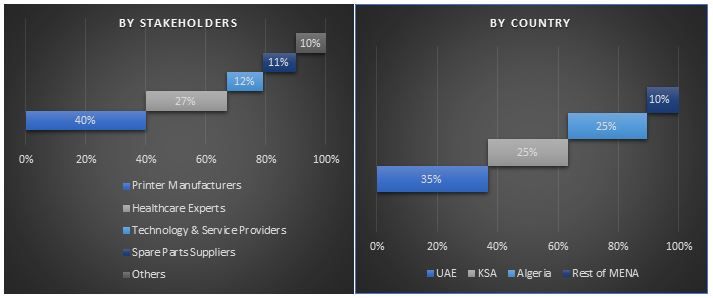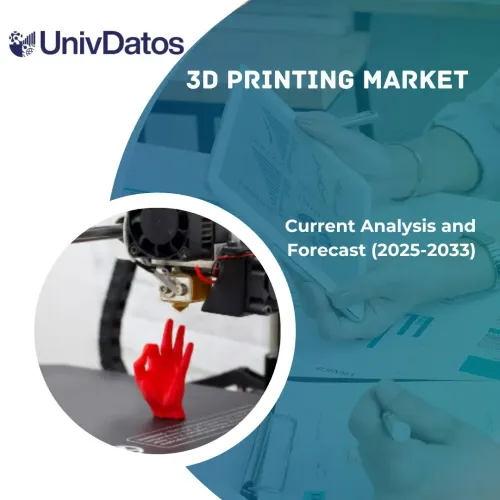- Home
- About Us
- Industry
- Services
- Reading
- Contact Us
MENA 3D Printing Market: Current Analysis and Forecast (2018-2024)
Emphasis on Component ((Product (Professional/Industrial Printer, Personal/Desktop 3D Printers), Material (Polymer, Plastic, Metals and Alloys, Ceramic, Other Materials), Technology ( Stereolithography, Selective Laser Sintering, Electron Beam Melting, Fused Deposition Modelling, Laminated object Manufacturing, Other Technologies))
As per the report published by UnivDatos Market Insights (UMI), the MENA 3D printing market is anticipated to reach the market valuation of US$ 1,373.8 Million by 2025 expanding at considerable CAGR of 12.7% during the forecasted period (2019-2025). Middle East Africa 3D Printing has witnessed notable growth and is poised to spiral to new heights in years to come. Most countries such as UAE, Qatar and Saudi Arabia are willing to seize the opportunities that are inbuilt in 3D printing and hence are gaining leading edge in the technological advancements. Moreover, the region portrays immense potential to radically transform the way medical devices are utilized to treat the patients. The technique has emerged as one of the cost efficient option for medical device industry and therefore has impacted the health care segment positively.
Surging demand for patient specific products in orthopedics and maxillofacial surgery coupled with consistent advancements in innovative technologies have exponentially driven the performance of Middle East 3D printing market. Moreover, increasing production of customized products, lower costs and government investments have accelerated 3D printing market of Middle East region.
Middle East Africa 3D printing has grown remarkably mainly accredited to booming acceptance of 3D technique in various industry verticals, rising regulatory support by government bodies and continuous disruption of manufacturing sector. The market was valued at US XX million in 2017 and is predicted to reach US 2,033.7 Million by 2024. The technology has dynamically proliferated across multiple manufacturing industries which can be witnessed among automotive, aerospace and healthcare industries coupled with electronics manufacturers and other medical suppliers. Furthermore, innovative technology has allowed the manufacturers to enhance their local production. However, high cost involved in 3D printing in terms of 3D printers and absence of resource pool in 3D printing and lack of technological understanding in 3D printing pose as some of the restricting factors hampering the potential of Middle East Africa 3D printing market.
Insights Presented in the Report:
- The report analyses 3D Printing market report majorly based on component, technology, applications and end users. Products, materials and services are the major components considered in the deep analysis of the 3D printing industry.
- Product segment is further classified into professional printers and desktop printers. Product segment is expected to register fastest growth, owing to increasing demand for desktop 3D printers over the period of time although industrial printers is projected to continue to display its dominance till 2024.
- Middle East Africa 3D printing material market is further divided into different material types including polymer, plastic, metal and alloys, ceramics and others materials. In 2017, polymer segment dominated the Middle East Africa 3D printing material market as they represent greatest penetration and user accessibility in 3D printing.
- Stereolithography, Selective Laser Sintering, Electron Beam Melting, Fused deposition modeling, Laminated object Manufacturing and Others are the major technologies considered while analyzing the regional 3D printing market. Fused Deposition Modelling, Selective Laser Sintering and Stereolithography constitute as the topmost technologies in 3D printing. Fused Deposition Modelling occupied the prominent share in 2017 as it is one of the prominent and user friendly technology that is widely used to create 3D printed objects.
- Based on application type, Middle East Africa 3D printing market is bifurcated into functional parts, fit and assembly, prototype modelling, education, metal casting, Visual Aids, Presentation Modelling and other applications. Functional parts captured maximum share during 2017 owing to its fast speed, quality and low cost of additive manufacturing.
- Furthermore, 3D printing techniques find its major application in verticals such as education, automotive, aerospace & defense, healthcare, consumer goods, manufacturing, construction and others. Manufacturing sector dominated 3D printing landscape during 2017 owing to bolstering digitalization wherein 3D printing solutions have paved way for manufacturing companies.
- For better understanding of the geographical penetration of 3D printing market in Middle East Africa, the market is analyzed based on its outreach in the countries such as UAE, Qatar, Saudi Arabia, Kuwait, Egypt, Algeria and rest of Middle East Africa. Saudi Arabia and Qatar constitute as the most leading and active countries in operating 3D technology wherein they undertake several research and development initiatives to revolutionize the advanced technologies applications. In addition, with the growing manufacturing sector in UAE and being the wider region, it also captures the major chunk of 3D printing market in Middle East region. 3D printing has become one of disruptive technology that is expected to have significant impact on the region’s industry owing to greatest growth prospects showcased particularly in aerospace, dental and construction sector of the country.
- Key companies profiled in the report include 3D Systems Corporation, Arcam AB, Royal DSM N.V., Stratasys Ltd., Autodesk, Inc., The ExOne Company, Hoganas AB, Organovo Holdings, Inc, Mcor Technologies Limited and Voxeljet AG.
Reasons to buy the Report:
- The study includes market sizing and forecasting analysis validated by authenticated key industry experts
- The report presents a quick review of overall industry performance at one glance
- The report covers in depth analysis of prominent industry peers with primary focus on key business financials, product portfolio, expansion strategies and recent developments
- Detailed examination on drivers, restraints, key trends and opportunities prevailing in the industry.
- Examination of industry attractiveness with the help of Porter’s Five Forces analysis
- The study comprehensively covers the market across different segments
- Deep dive regional level analysis of the industry
Customization Options:
The MENA 3D Printing Market can be customized to the regional country level or any other market segment. Besides this, UMI understands that you may have your own business need, hence we also provide fully customised solutions to clients.
Table of Content
Analysing historical market, estimation of the current market and forecasting the future market for MENA 3D Printing market were the three major steps undertaken to create and analyse the overall adoption of 3D Printing in different countries of MENA region. Exhaustive secondary research was conducted to collect the historical market of the product/technology and overall estimation of the current market. Secondly, to validate these insights, numerous findings and assumptions were taken into consideration. Moreover, exhaustive primary interviews were conducted with industry experts across value chain of the MENA 3D printing market. After all assumption, market engineering and validation of market numbers through primary interviews, top-down approach was employed to forecast the market size of 3D Printing in the MENA region to 2024. Thereafter, market breakdown and data triangulation methods were adopted to estimate and analyse the market size of segments and sub-segments of the market. Detailed research methodology is explained below:
Analysis of Historical Market Size
Step 1: In-Depth Study of Secondary Sources:
Detail secondary study was conducted to obtain the historical market size of the MENA 3D Printing market through company internal sources such as annual report & financial statements of top players, performance presentations, press releases, sales figures etc. and external sources including journals, news & articles, government publications, competitor publications, sector reports, third-party database and other creditable publications.
Step 2: Market Segmentation:
After obtaining historical market size of the overall market, detailed secondary analysis was conducted to gather historical market insights and share for different segments & sub-segments for the MENA 3D Printing market. Major segments included in the report are component, technology, application and end-user.
Step 3: Factor Analysis:
After acquiring the historical market size of different segments and sub-segments, detailed factor analysis was conducted to estimate the current market size of the MENA 3D Printing market. Factor analysis was conducted using dependent and independent variable such as purchasing power, player initiatives, penetration of 3D printing, government regulations in different regions. Historical trends of the MENA 3D Printing and their year-on-year impact on the market size and share in the recent past were analyzed. Demand and supply side scenario was also thoroughly studied.
Current Market Size Estimate & Forecast
Current Market Sizing: Based on actionable insights from the above 3 steps, we arrived at current market size, key players in market, market share of these players, industry’s supply chain, and value chain of the industry. All the required percentage shares, splits, and market breakdowns were determined using the above-mentioned secondary approach and were verified through primary interviews.
Estimation & Forecasting: For market estimation and forecast, weightage was assigned to different factors including drivers & trends, restraints, and opportunities available in the market. After analyzing these factors, relevant forecasting techniques i.e. Bottom-up/Top-down was applied to arrive at the market forecast pertaining to 2024 for different segment in major countries of MENA region. The research methodology adopted to estimate the market size encompasses:
- The industry’s market size and rate of adoption of 3D Printing technology in MENA region in terms of value (US$)
- All percentage shares, splits, and breakdowns of market segments and sub-segments
- Key players across different technologies and markets as well as market share of each player. Also, the growth strategies adopted by these players to compete in the rapidly growing MENA 3D Printing market
Market Size and Share Validation
Primary Research: In-depth interviews were conducted with the Key Opinion Leaders (KOLs) including Top Level Executives (CXO/VPs, Sales Head, Marketing Head, Operational Head, and Regional Head etc.). Primary research findings were summarized and statistical analysis was performed to prove the stated hypothesis. Input from primary research were consolidated with secondary findings, hence turning information into actionable insights.
Split of Primary Participants
Market Engineering
Data triangulation technique was employed to complete the overall market engineering process and to arrive at precise statistical numbers of each segment and sub-segment pertaining to the MENA 3D Printing market. Data was split into several segments & sub-segments post studying several parameters and trends.
Main objective of the MENA 3D Printing Market Study
The current & future market trends of the MENA 3D Printing are pinpointed in the study. Investors can gain strategic insights to base their discretion for investments from the qualitative and quantitative analysis performed in the study. Current and future market trends would determine the overall attractiveness of the market, providing a platform for the industrial participant to exploit the untapped market to benefit as first mover advantage. Other quantitative goal of the studies includes:
- Analyse the current and forecast market size of the MENA 3D Printing market in terms of value (US$)
- Analyse the current and forecast market size of different segments and sub-segments of the MENA 3D Printing market. Segments in the study include component, technology, application and end-user
- Define and describe the technologies and protocols used in the 3D Printing
- Anticipate potential risk present within the industry along with analysing the customer and competitor in the market
- Define and analysis of the government regulations for the 3D Printing in different countries in the MENA region
- Analyse the current and forecast market size of 3D Printing, for countries including UAE, KSA, Kuwait, Algeria, Egypt, Qatar and Rest of MENA
- Define and analyse the competitive landscape for the MENA 3D Printing market and the growth strategies adopted by the market players to sustain in the rapidly growing market
Related Reports
Customers who bought this item also bought











